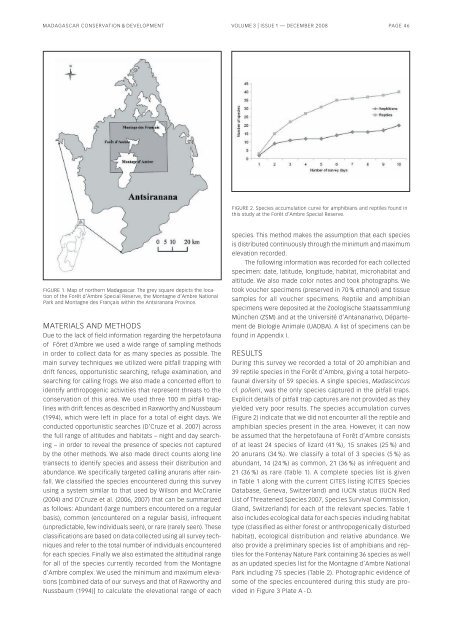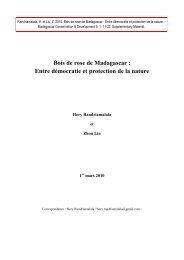Journal Madagascar Conservation - Madagascar Wildlife ...
Journal Madagascar Conservation - Madagascar Wildlife ...
Journal Madagascar Conservation - Madagascar Wildlife ...
You also want an ePaper? Increase the reach of your titles
YUMPU automatically turns print PDFs into web optimized ePapers that Google loves.
MADAGASCAR CONSERVATION & DEVELOPMENT VOLUME 3 | ISSUE 1 — DECEMBER 2008 PAGE 46<br />
FIGURE 1. Map of northern <strong>Madagascar</strong>. The grey square depicts the location<br />
of the Forêt d’Ambre Special Reserve, the Montagne d’Ambre National<br />
Park and Montagne des Français within the Antsiranana Province.<br />
MATERIALS AND METHODS<br />
Due to the lack of field information regarding the herpetofauna<br />
of Fôret d‘Ambre we used a wide range of sampling methods<br />
in order to collect data for as many species as possible. The<br />
main survey techniques we utilized were pitfall trapping with<br />
drift fences, opportunistic searching, refuge examination, and<br />
searching for calling frogs. We also made a concerted effort to<br />
identify anthropogenic activities that represent threats to the<br />
conservation of this area. We used three 100 m pitfall trap-<br />
lines with drift fences as described in Raxworthy and Nussbaum<br />
(1994), which were left in place for a total of eight days. We<br />
conducted opportunistic searches (D’Cruze et al. 2007) across<br />
the full range of altitudes and habitats – night and day searching<br />
– in order to reveal the presence of species not captured<br />
by the other methods. We also made direct counts along line<br />
transects to identify species and assess their distribution and<br />
abundance. We specifically targeted calling anurans after rainfall.<br />
We classified the species encountered during this survey<br />
using a system similar to that used by Wilson and McCranie<br />
(2004) and D’Cruze et al. (2006, 2007) that can be summarized<br />
as follows: Abundant (large numbers encountered on a regular<br />
basis), common (encountered on a regular basis), infrequent<br />
(unpredictable, few individuals seen), or rare (rarely seen). These<br />
classifications are based on data collected using all survey techniques<br />
and refer to the total number of individuals encountered<br />
for each species. Finally we also estimated the altitudinal range<br />
for all of the species currently recorded from the Montagne<br />
d’Ambre complex. We used the minimum and maximum elevations<br />
[combined data of our surveys and that of Raxworthy and<br />
Nussbaum (1994)] to calculate the elevational range of each<br />
FIGURE 2. Species accumulation curve for amphibians and reptiles found in<br />
this study at the Forêt d’Ambre Special Reserve.<br />
species. This method makes the assumption that each species<br />
is distributed continuously through the minimum and maximum<br />
elevation recorded.<br />
The following information was recorded for each collected<br />
specimen: date, latitude, longitude, habitat, microhabitat and<br />
altitude. We also made color notes and took photographs. We<br />
took voucher specimens (preserved in 70 % ethanol) and tissue<br />
samples for all voucher specimens. Reptile and amphibian<br />
specimens were deposited at the Zoologische Staatssammlung<br />
München (ZSM) and at the Université d’Antananarivo, Département<br />
de Biologie Animale (UADBA). A list of specimens can be<br />
found in Appendix I.<br />
RESULTS<br />
During this survey we recorded a total of 20 amphibian and<br />
39 reptile species in the Forêt d’Ambre, giving a total herpetofaunal<br />
diversity of 59 species. A single species, Madascincus<br />
cf. polleni, was the only species captured in the pitfall traps.<br />
Explicit details of pitfall trap captures are not provided as they<br />
yielded very poor results. The species accumulation curves<br />
(Figure 2) indicate that we did not encounter all the reptile and<br />
amphibian species present in the area. However, it can now<br />
be assumed that the herpetofauna of Forêt d’Ambre consists<br />
of at least 24 species of lizard (41 %), 15 snakes (25 %) and<br />
20 anurans (34 %). We classify a total of 3 species (5 %) as<br />
abundant, 14 (24 %) as common, 21 (36 %) as infrequent and<br />
21 (36 %) as rare (Table 1). A complete species list is given<br />
in Table 1 along with the current CITES listing (CITES Species<br />
Database, Geneva, Switzerland) and IUCN status (IUCN Red<br />
List of Threatened Species 2007, Species Survival Commission,<br />
Gland, Switzerland) for each of the relevant species. Table 1<br />
also includes ecological data for each species including habitat<br />
type (classified as either forest or anthropogenically disturbed<br />
habitat), ecological distribution and relative abundance. We<br />
also provide a preliminary species list of amphibians and reptiles<br />
for the Fontenay Nature Park containing 36 species as well<br />
as an updated species list for the Montagne d’Ambre National<br />
Park including 75 species (Table 2). Photographic evidence of<br />
some of the species encountered during this study are provided<br />
in Figure 3 Plate A - D.



